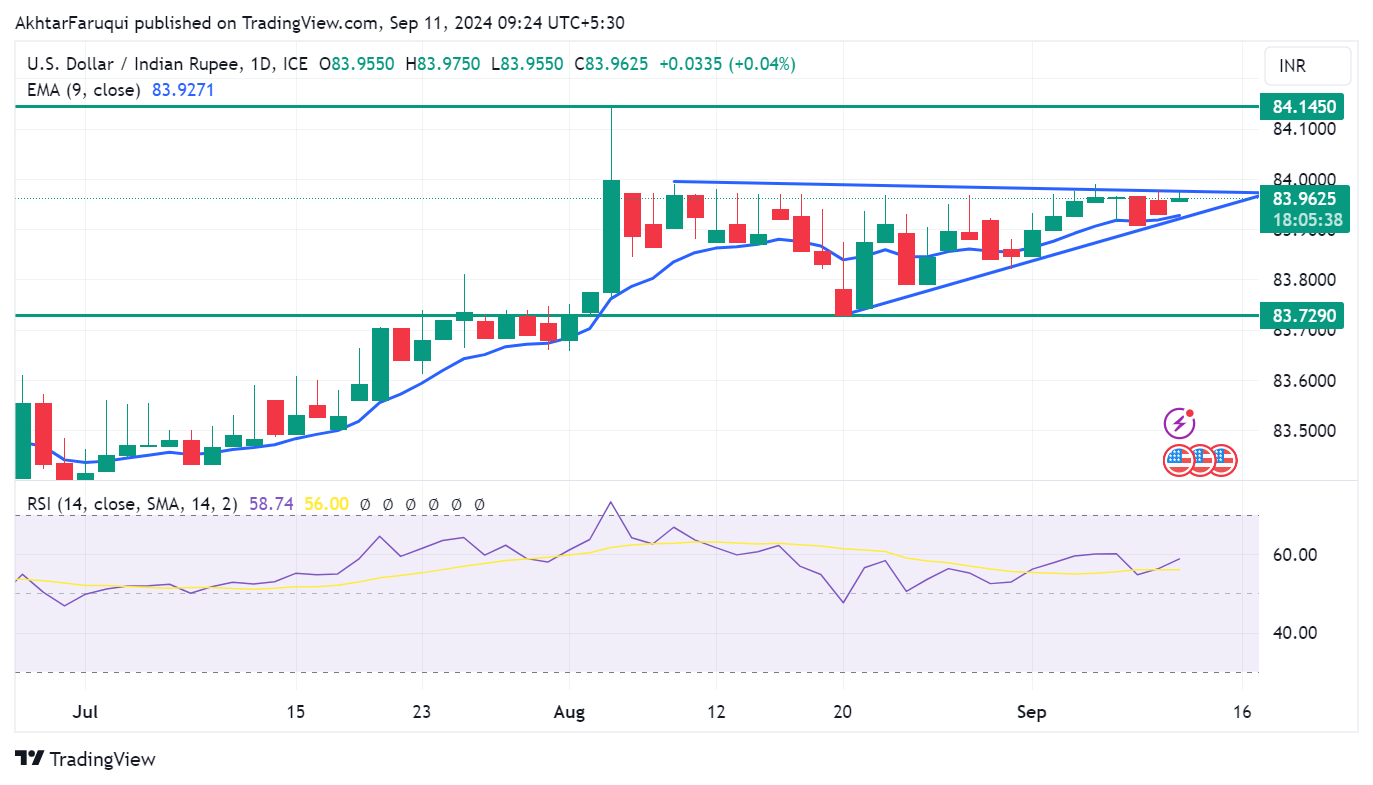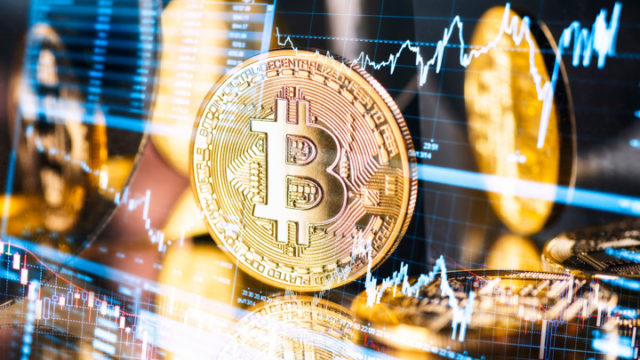- The Indian Rupee remains stable amid growing speculation over RBI interventions in open currency markets.
- Lower crude oil prices are supportive of the INR as India is the world’s third-largest consumer and importer of oil.
- The US Dollar depreciates as Treasury yields continue to decline ahead of the Consumer Price Index data.
The USD/INR pair remains confined in a range around the 84.00 level on Wednesday. Traders are speculating on possible interventions by the Reserve Bank of India (RBI) in the open forex market to support the Indian Rupee (INR) and prevent it from weakening beyond the 84.00 level.
The Indian Rupee gained support against the US Dollar (USD) on the back of falling crude oil prices. This could ease downward pressure on the INR as India, the world’s third-largest oil consumer and importer, would benefit from lower import costs. Concerns over weakening global demand led Brent crude futures to fall to their lowest level of $64.75 per barrel since December 2021.
The US Dollar (USD) faces challenges as US Treasury yields continue to decline ahead of the US Consumer Price Index (CPI) data scheduled to be released later in North American hours. This inflation report may offer fresh clues about the potential magnitude of the Federal Reserve’s (Fed) interest rate cut in September.
Daily Market Wrap: Indian Rupee consolidates amid growing speculation over RBI interventions
- According to the CME’s FedWatch tool, markets are fully anticipating at least a 25 basis point (bp) rate cut by the Federal Reserve at its September meeting. The probability of a 50 bp rate cut has declined slightly to 31.0%, from 38.0% a week ago.
- The first US presidential debate between former President Donald Trump and Democratic candidate Kamala Harris in Pennsylvania began with a critical focus on the economy, inflation and economic policies. Trump commented: “We have a terrible economy. We have inflation that is probably the worst in history. This has been a disaster for people.”
- On Tuesday, Reuters reported that six Indian bankers indicated that investors are urging the Indian federal government to increase issuance of short-term and green bonds and restart auctions of floating-rate bonds. These recommendations were discussed during a series of meetings on the government’s borrowing strategy for the second half of the fiscal year.
- Chicago Fed President Austan Goolsbee commented on Friday that Fed officials are starting to align with broader market sentiment that a rate policy adjustment by the U.S. central bank is imminent, according to CNBC. FXStreet’s FedTracker, which uses a custom AI model to rate Fed officials’ speeches on a dovish-to-hawkish scale from 0 to 10, rated Goolsbee’s comments as dovish, assigning them a score of 3.2.
- India’s foreign exchange reserves hit a record high of $683.99 billion as of August 30, up from $681.69 billion previously. This increase is largely due to a substantial inflow of foreign exchange into the Indian economy, driven by strong economic growth and the much-awaited inclusion of Indian assets in JPMorgan’s main emerging market debt index, which has enhanced foreign investment.
- “India’s Composite PMI continued to show strong growth in August, driven by an acceleration in business activity in the services sector, which saw its fastest expansion since March. This growth was largely driven by a surge in new orders, particularly domestic orders,” said Pranjul Bhandari, Chief India Economist at HSBC.
Technical Analysis: USD/INR remains below 84.00, the upper boundary of the symmetrical triangle
The Indian Rupee is trading around 84.00 on Wednesday. An analysis of the daily chart shows that the USD/INR pair is consolidating within a symmetrical triangle pattern, suggesting a reduction in volatility and a period of consolidation. Nevertheless, the 14-day Relative Strength Index (RSI) remains above 50, signaling an uptrend.
On the downside, the nine-day exponential moving average (EMA) at 83.92 could act as an immediate support, coinciding with the lower boundary of the symmetrical triangle near 83.90. A drop below this level could signal a bearish turn, potentially putting downward pressure on the USD/INR pair and pushing it towards the six-week low at 83.72.
On the resistance side, the USD/INR pair is testing the upper boundary of the symmetrical triangle near the level of 84.00. A break above this point could lead the pair towards the all-time high of 84.14, recorded on August 5.
USD/INR: Daily Chart
Indian Rupee FAQs
The Indian Rupee (INR) is one of the most sensitive currencies to external factors. The price of crude oil (the country relies heavily on imported oil), the value of the US Dollar (most trade is done in US Dollars) and the level of foreign investment are all influential factors. Direct intervention by the Reserve Bank of India (RBI) in the foreign exchange markets to keep the exchange rate stable, as well as the level of interest rates set by the RBI, are other important factors that influence the Rupee.
The Reserve Bank of India (RBI) actively intervenes in the foreign exchange markets to maintain a stable exchange rate and help facilitate trade. In addition, the RBI attempts to keep the inflation rate at its 4% target by adjusting interest rates. Higher interest rates typically strengthen the Rupee. This is due to the role of the “carry trade,” where investors borrow from countries with lower interest rates to place their money in countries offering relatively higher interest rates and profit from the difference.
Macroeconomic factors that influence the value of the Rupee include inflation, interest rates, economic growth rate (GDP), trade balance, and foreign investment inflows. A higher growth rate can lead to higher overseas investment, increasing demand for the Rupee. A less negative trade balance will eventually lead to a stronger Rupee. Higher interest rates, especially real rates (interest rates minus inflation) are also positive for the Rupee. A risk-off environment can lead to higher foreign direct and indirect investment (FDI and FII) inflows, which also benefit the Rupee.
Higher inflation, particularly if it is comparatively higher than other countries, is generally negative for the currency as it reflects a devaluation through excess supply. Inflation also increases the cost of exports, leading to more rupees being sold to buy foreign imports, which is negative for the Indian Rupee. At the same time, higher inflation usually leads the Reserve Bank of India (RBI) to raise interest rates and this can be positive for the Rupee, due to increased demand from international investors. The opposite effect applies to lower inflation.
Source: Fx Street
I am Joshua Winder, a senior-level journalist and editor at World Stock Market. I specialize in covering news related to the stock market and economic trends. With more than 8 years of experience in this field, I have become an expert in financial reporting.








